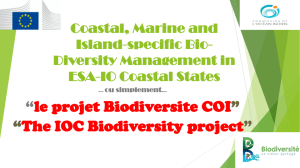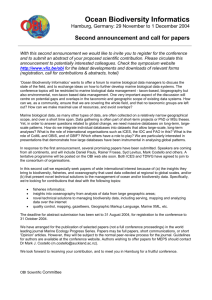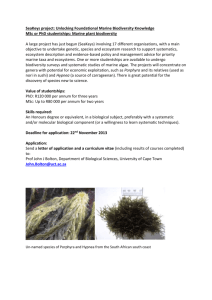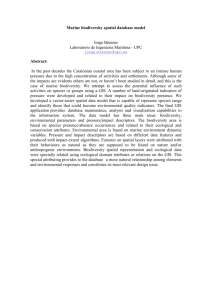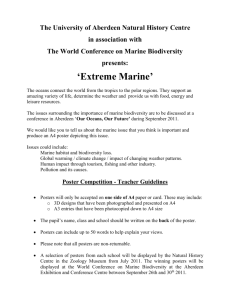Meiners, César, Centro de Ecología y Pesquerías, Universidad Veracruzana, Mexico
advertisement
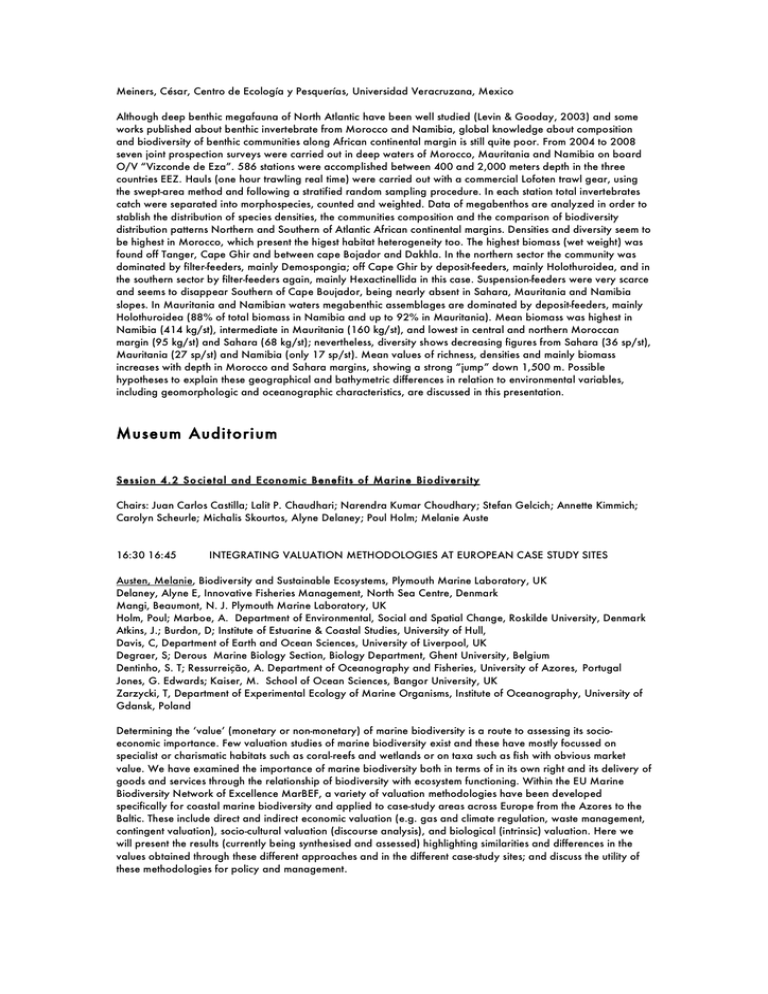
Meiners, César, Centro de Ecología y Pesquerías, Universidad Veracruzana, Mexico Although deep benthic megafauna of North Atlantic have been well studied (Levin & Gooday, 2003) and some works published about benthic invertebrate from Morocco and Namibia, global knowledge about composition and biodiversity of benthic communities along African continental margin is still quite poor. From 2004 to 2008 seven joint prospection surveys were carried out in deep waters of Morocco, Mauritania and Namibia on board O/V “Vizconde de Eza”. 586 stations were accomplished between 400 and 2,000 meters depth in the three countries EEZ. Hauls (one hour trawling real time) were carried out with a commercial Lofoten trawl gear, using the swept-area method and following a stratified random sampling procedure. In each station total invertebrates catch were separated into morphospecies, counted and weighted. Data of megabenthos are analyzed in order to stablish the distribution of species densities, the communities composition and the comparison of biodiversity distribution patterns Northern and Southern of Atlantic African continental margins. Densities and diversity seem to be highest in Morocco, which present the higest habitat heterogeneity too. The highest biomass (wet weight) was found off Tanger, Cape Ghir and between cape Bojador and Dakhla. In the northern sector the community was dominated by filter-feeders, mainly Demospongia; off Cape Ghir by deposit-feeders, mainly Holothuroidea, and in the southern sector by filter-feeders again, mainly Hexactinellida in this case. Suspension-feeders were very scarce and seems to disappear Southern of Cape Boujador, being nearly absent in Sahara, Mauritania and Namibia slopes. In Mauritania and Namibian waters megabenthic assemblages are dominated by deposit-feeders, mainly Holothuroidea (88% of total biomass in Namibia and up to 92% in Mauritania). Mean biomass was highest in Namibia (414 kg/st), intermediate in Mauritania (160 kg/st), and lowest in central and northern Moroccan margin (95 kg/st) and Sahara (68 kg/st); nevertheless, diversity shows decreasing figures from Sahara (36 sp/st), Mauritania (27 sp/st) and Namibia (only 17 sp/st). Mean values of richness, densities and mainly biomass increases with depth in Morocco and Sahara margins, showing a strong “jump” down 1,500 m. Possible hypotheses to explain these geographical and bathymetric differences in relation to environmental variables, including geomorphologic and oceanographic characteristics, are discussed in this presentation. Museum Auditorium Session 4. 2 So cietal and E conomic Benefits of Marine Bi odiversity Chairs: Juan Carlos Castilla; Lalit P. Chaudhari; Narendra Kumar Choudhary; Stefan Gelcich; Annette Kimmich; Carolyn Scheurle; Michalis Skourtos, Alyne Delaney; Poul Holm; Melanie Auste 16:30 16:45 INTEGRATING VALUATION METHODOLOGIES AT EUROPEAN CASE STUDY SITES Austen, Melanie, Biodiversity and Sustainable Ecosystems, Plymouth Marine Laboratory, UK Delaney, Alyne E, Innovative Fisheries Management, North Sea Centre, Denmark Mangi, Beaumont, N. J. Plymouth Marine Laboratory, UK Holm, Poul; Marboe, A. Department of Environmental, Social and Spatial Change, Roskilde University, Denmark Atkins, J.; Burdon, D; Institute of Estuarine & Coastal Studies, University of Hull, Davis, C, Department of Earth and Ocean Sciences, University of Liverpool, UK Degraer, S; Derous Marine Biology Section, Biology Department, Ghent University, Belgium Dentinho, S. T; Ressurreição, A. Department of Oceanography and Fisheries, University of Azores, Portugal Jones, G. Edwards; Kaiser, M. School of Ocean Sciences, Bangor University, UK Zarzycki, T, Department of Experimental Ecology of Marine Organisms, Institute of Oceanography, University of Gdansk, Poland Determining the ‘value’ (monetary or non-monetary) of marine biodiversity is a route to assessing its socioeconomic importance. Few valuation studies of marine biodiversity exist and these have mostly focussed on specialist or charismatic habitats such as coral-reefs and wetlands or on taxa such as fish with obvious market value. We have examined the importance of marine biodiversity both in terms of in its own right and its delivery of goods and services through the relationship of biodiversity with ecosystem functioning. Within the EU Marine Biodiversity Network of Excellence MarBEF, a variety of valuation methodologies have been developed specifically for coastal marine biodiversity and applied to case-study areas across Europe from the Azores to the Baltic. These include direct and indirect economic valuation (e.g. gas and climate regulation, waste management, contingent valuation), socio-cultural valuation (discourse analysis), and biological (intrinsic) valuation. Here we will present the results (currently being synthesised and assessed) highlighting similarities and differences in the values obtained through these different approaches and in the different case-study sites; and discuss the utility of these methodologies for policy and management.

